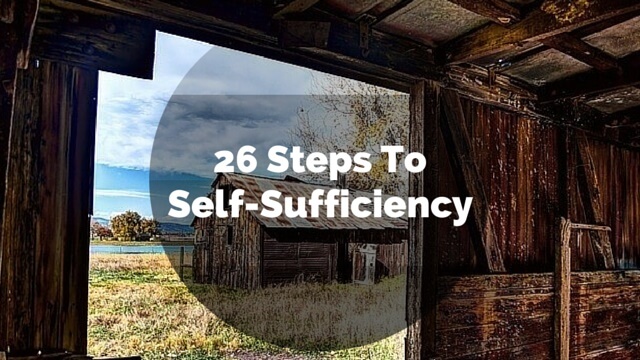People that are trying to live a simpler lifestyle sometimes struggle with where to begin. Here are 26 steps to self sufficiency that anyone can do with not too much effort; just make sure you have a well thought out plan so that you do not become overwhelmed.
1. Plant a garden :
This is the basic building block for anyone looking to walk a simpler path in life in the modern world. Especially with rising fuel costs and resulting food costs increases it is imperative to minimize the impact on a families financial situation. More and more of the average families monthly income is slowly being eroded by the cost of just putting food on the table. I understand a lot of people do not have a lot of land to totally grow their own food but there are many options available to grow in small footprint and help at least offset the cost of groceries. Besides it also helps develop ones skills for any future plans.
2. Learn how to can your own food :
This goes hand in hand with planting a garden, a garden will produce way to much food at one time for any family to consume it all before it goes to waste. Having the skills to be able to preserve what you produce is imperative for a families long term self sufficiency. If your garden is to small at the moment to produce enough food to put away in the pantry there are other options available. Search out and visit farmers markets, talk to the farmers about buying in bulk which can save you some money. Ask the farmers about gleaning the fields after harvest time. A lot of farmers will allow people to harvest produce that has been leftover and missed after the commercial harvesting is done. Look into a local produce supplier for restaurants. Most of them have a walk in window where people can go in and buy bulk produce. You can buy a 25 pound case of tomatoes for about 18 dollars right now which is a huge cost savings over the grocery store and that would make quite a few jars of spaghetti sauce.
3. Plant a herb garden :
Have you seen how much both fresh and dried herbs are at the grocery store are? It’s insane. The amount of space needed to raise a small herb garden is minimal and there is nothing like fresh herbs.
4. Get a dehydrator :
Dehydrating Food and Canning go hand in hand. The options you have with a dehydrator is only limited by your imagination. You can make jerky, fruit roll ups, dehydrate eggs, etc. Fruits make a tasty healthy snack for young and old. Most locations in the country have local orchards that are a great place to buy fruits cheaply and dehydrated apple slices sprinkled with cinnamon last a long time on the pantry shelf and are delicious.
5. Plant Perennials you can eat :
Growing up as a child in a small city in western New York we did not have a very large yard, but we did have a garden space and perennials that supplied a food source each year with no work on our part. Asparagus, Rhubarb, Strawberries, Jerusalem Artichokes. etc.
6. Plant soft fruits :
Along with strawberries also plant raspberries, blackberries, blueberries etc.. They do not take up a lot of space and will produce fresh and tasty fruits year after year
7. Plant a few fruit trees :
with modern day dwarf varieties that are available on the market today you can plant a few fruit trees that with pruning and training will be bountiful in several years without taking up much room at all.
8. Learn to save seeds :
Buy heirloom open-pollinated seeds and learn to save the seeds from this years produce to be able to plant next year. I know of families that have been passing their seed stock down through the family for over 100 years and haven’t had to buy a seed ever.
9. Raise a few small backyard animals :
The amount of space required by a small flock of chickens or rabbit hutch is minimal and is a great source for nutrients for you and your backyard farm. There is nothing better than making breakfast or a cake with eggs fresh from the source. Plus they are a great asset with help keeping bugs and insects in check and will gladly take care of any extra vegetables or fruit from the garden for you.
10. Compost everything :
People think compost is smelly and disgusting. If your compost is creating a nuisance smell, you are doing it wrong. It is estimated that 30 to 40 percent of food Americans buy ends up in the trash heap. Any waste from leftovers either goes into to the compost pile by either being fed to the chickens and after working its way through the chickens ends up in the compost bin or we will put it directly in the piles. All raked leaves, newspaper, cardboard, weeds, grass clippings etc goes directly into our compost pile.
11. Waste not want not :
Touching on the estimate of amount of food thrown out, learn to cook only what someone is able to eat. Unless you are making a big pot of chili to can and put in the pantry, why use all the time, energy and money to make something that you will end up throwing away.
12. Cook from scratch :
The average American has lost touch with what food actually is. Most people think that food comes out of a box and sadly it usually does for a large percentage of Americans in today’s world. Pick up several basic cookbooks and experiment with turning your backyard bounty into healthy, nutritious and tasty meals for your family.
13. Learn to make your own adult beverages :
Cider, Wine and Beer. They are simple to make and you can make them for a fraction of what it costs to buy the mass produced product available in the stores today. I listed them in the order that I believe is the easiest to make in your own home. Wine you can make out of just about anything, even things that you would never think of such as tomatoes, carrots, pumpkin and dandelions. Experimenting is half the fun in my opinion.
14. Learn to hunt and fish :
Wild game is a great way to add a healthy protein option into your home for not a lot of money. There is nothing I like better than a nice lean venison steak or a cornmeal battered catfish fish fry. You can easily can wild game as well in a pressure canner to make it shelf stable.
15. Start a small Apiary :
This is one of the projects of the short list of things I want to do. From a sustainability stand point bees are the little helpers of the garden and orchard that most people despise out of fear. These little workers will pollinate your plants, produce fresh honey, create bees wax for soap making, candle making, furniture polish, etc..
16. Rainwater Collection:
In a few hours you can quickly establish a rain water collection system. One inch of rain will give you .6 gallons of water per square foot of roof space. Depending on your space and average rain fall you can build a simple 50 gallon system up to several thousand gallons. We use our rainwater for watering the garden and animals and it costs us nothing except for the initial cost of the system.
17. Make your own dairy products :
Dairy products such as cheese, yogurt, butter and ice cream are going through the roof right now and it is one of the simpler things to make in your kitchen. It is a fun project to get the kids involved with as well.
18. Grind your own flour and Bake your own bread :
There are several grinders on the market today that will easily convert wheat berries into whole flour. The added benefit is wheat berries if properly stored will last much longer than flour in the pantry and you have the added benefit of capturing all the nutritional value of the wheat. Not the bleached product available on the market today that has been processed so much there is little if any nutritional value left in it. You can also grind your own cornmeal to make corn bread with. There is nothing better than a thick slab of homemade bread that you created from a raw product lathered with your own homemade butter.
19. Set up a clothes line :
One of the largest electrical drains on a homes monthly electric bill is the electric dryer. The average consumer spends money on chemicals and products to mimic that fresh spring smell. Guess what, you can hang your clothes up on a clothes line, save money on electricity and get that fresh spring smell for free!
20. Make your own soaps:
Hand soap. dish detergent and laundry detergent can be made for pennies on the dollar compared to the mass produced product available on the market today. There was a news report recently where Tide is becoming a hot commodity for theft by shoplifting because of the rise in prices.
21. Start a worm farm :
Worms are another little helper around the homestead that are worth their weight in gold. They help compost and is one of the best ways to help enrich your soil. You can use them to create a fertilizer tea that is one of the best organic fertilizers you can use in your backyard. You could also start a worm business to sell to sporting good stores and fisherman to create a little extra cash flow.
22. Build a smoker :
Smoking meats, vegetables and cheeses is a great hobby and adds a tremendous amount of flavor for next to nothing that will be a welcome addition to your recipes and meals.
23. Cut your own hair :
For me this is simple, I have had a buzz cut since I was born and for the cost of a decent pair of clippers you can save the 20 dollars a month it costs to lower your ears.
24. Re-purpose Everything:
I hate throwing things out. I don’t consider myself a pack rat but if I can use a item for another purpose I will do it. It saves on a trash bill and will save on the cost of purchasing something new.
25. Try and live debt free as much as possible:
Debt is slavery. We as citizens spend way to much of our hard earned dollars on interest. This is more difficult than it sounds though. We were finally able to get rid of our credit cards 6 years ago and don’t buy something unless we can save the money to afford it.
26. Look into Alternative Energy Sources :
This can be as expensive as someone is willing to spend. Most people think alternative energy means solar panels but something as simple as installing a wood stove would have a huge impact on your heating bill and dependency on foreign oil. The nice thing about wood heat is that it has the ability to heat you twice, the day you cut and split it and the day you burn it. You just can’t beat the heat from a wood stove in my opinion.






awesome as always
great ideas
One at a time does it. Great ideas.
Love this post! Good information with out a bunch of filler ;). Exactly what I have been looking for.
Great read!
One task a month and in two years we’re set!
And let’s not forget a clothesline!:). And for some of a washboard and basin!
Thank you for all the ideas!
Happy and Healthy living to ya’ll!
thanks Tanya, I didn’t forget the clothesline, that’s number 19, lol,
be safe
Thanks for pointing out that some of these can be done even in the smallest of apartments. I live in a 600 sq ft upstairs apartment downtown with no windows to the outside world. We’ve already done a lot of these things, including a garden (got a plot at the local community garden), canning and preserving, making bread from scratch, making our own soaps, and even hanging our clothes to dry (can’t do that Oct – March, though). Being tight on money gave us the excuse to learn these things.
I’ definitely sharing this!
Hey Sunfire, you actually can hang your clothes to dry in the winter, even in your apartment. If you go on to the Lehman’s store website you will find a compact clothes line that can be stretched across any room in the house. It retracts when you are not using it. It has helped us save a lot of money in electrical bills since we did it.
love the adult beverages tip … 😀
Great list. I’m 70% of the way there and working on a few of the others. Thank you. -AJ
I love this list, it takes me longer to get things done (health issues) but, I truly believe a lot of this would improve my overall health and the world around me while providing necessary things in life. I think also turning back the times is what most of the country needs desperately right now. I plan to move soon, and will start on this list a little at a time, can’t wait and to teach my child along the way will be so beneficial as whom knows what the future of this country holds for that generation, the many roles we “should” have as parents. Love this post !!!! Saving!!
Thank-you Amy, and I agree
Nice article. It is wonderful to get to the self-sufficient state! I hope to be there someday. In the meantime, we are doing many of the things on your list!
Clotheslines are great, but when it’s heating season, if you have a wood stove, try getting a wooden clothes dryer rack. Just do a load of laundry before bed, set the items on the rack – they’ll be dry by morning. A friend of mine who doesn’t have a wood stove just hangs her clothes in the house to dry.
We purchased a wonderful wooden drying rack from some Amish in a nearby settlement. It is so much heavier, and sturdier than anything you could find at Walmart – I’ve even set it outside in the breeze, and only in heavy winds was there an issue. My point?? I guess that quality does make a big difference, and if you have Amish stores nearby, that’s a great place to check out. 🙂
Our clothes dryer just recently broke. Instead of getting it fixed or investing in another one, we’re just hanging the clothes on a wood drying rack. I do need to find at least one more (we are a family of 6), but that $20 will be a lot cheaper than the cost of a dryer and the electricity to run it.
Great list!
Great ideas! We’re moving in Jan from the city to a rural, coastal area, and have already planned the garden and chicken coop. I love hanging clothes on the line, so that’ll be another treat. I’m looking forward to working down your list, although I won’t be cutting hair!
Love it, but it seems like it needs a full time person to do it.
not really, it’s all about building skills a little at a time, don’t try and do all 26 things, pick one or two and work on those, then move onto others once you feel comfortable, even if you only do 6 of these, you will be far ahead of the game.
I already do about 80% of these, including the garden, edible perennials, the bees, fruit trees, berries, making bread,clothesline putting in a greenhouse is next, then the solar array. I can foods, including meats, dehydrate, make bread, though I don’t grind my own wheat yet. I let my cousins raise the animals (and eggs), and hunt, and I help clean and package the meat. The house has three springs, so I skip the water collection. Mostly debt free, though that comes and goes as situations change( surgery). The cousins with the dairy farm are also close by. Our furnace is oil, and wood burning, and we have a pelllet stove in the living room. Yes, wooden racks to hang clothes on at night by the stove takes care of one load per day. We don’t look at it as anything special, it comes from living in Vermont, lol.
excellant list !! way to go whoever out there did this !!
thank-you
This is so helpful, thanks very much!
Don’t forget to make your own medicine!!! Which goes along with herb gardening. But even many of the culinary herbs are used for medicine, as well as adding other powerful medicinal herbs to your gardens.
Garlic and Raw honey is HUGE medicine in our family. We steep it and take it as a potent medicine for everything.
Elderberries
Chamomile
Lemon Balm
Nettles
Oregano
GoldenSeal
You can make powerful vitamin C with dried and ground citrus peels.
23.5
Don’t cut your hair, or shave if you do not have to…Major savings not buying blades and shave soap.
e brew list! I have added Kambucha to my brewsh. Keifer to the dairy. Am planning to build a small aquponic system to grow indoor veg and fish ohelpver the winter – to start. Barter/trade. It’s a great way to help and get ifhelp. I do it with my friends based on time. Doesn’t matter g task or what schooling/experience the person has. Time and energy is time and energy. If I have extra canning etc I trade it for variety. Need to work on the chickens and some type of clothes washer – I have none! Visits to friends might have me bringing a bag 😉 I find this can be a lot of work, especially the thought of adding animals to tend. I look forward to a partner to work together with.
Keep on writing, great job!
[…] 26 Steps To Self Sufficiency […]
[…] By Author KVR 26 steps to self sufficiency! 1. Plant a garden : This is the basic building block for anyone looking to walk a simpler path in life in the modern world. Especially with rising fuel costs and resulting food costs increases it is imperative to minimize the impact on a families financial situation. More and more of the average families monthly income is slowly being eroded by the cost of just putting food on the table. I understand a lot of people do not have a lot of land to totally grow their own food but there are many options available to grow in small footprint and help at least offset the cost of groceries. Besides it also helps develop ones skills for any future plans. Read the other 25 steps>>>http://thehomesteadingboards.com/2012/05/26-steps-to-self-sufficiency/ […]
[…] 26 steps to self sufficiency […]
[…] 26 Steps to Self-Sufficiency […]
it stands to reason that the first step in all of this is to actually own your own property. if you are like most of the US you do not own your own property. there is, and always will be, a tax lien on it. you must get allodial title before you do any improvements. until then all you have is real estate (property from the ground up) that you are perpetually renting from the government which can be taken from you (imminent domain, Agenda 21, etc.) from you at any time.
We are going to add to the list, using pallets to make furniture! They ususally are free and easy to piece together! Also you can get imperfects from the Amish communities and at a bargain and they may even barter. This year I raised a garden, canned, learned how to dehydrate almost anything, raised hens for eggs, and am moving to a piece of land and going to erect a yurt. So while we may have to pay taxes on the land, we don’t pay on the house, hen house, tack room, or shed. I make my own bath bombs, skin softener, laundry soap and fabric softener and find I can do all of these different things while workng a part time job of 25 hours a week. I repurpose things and sell them on craigslist too for added money, sell our eggs and vegetables and canned goods too. I found fabric scraps from a lady who makes custom pillows for my jars and I wrap tp rolls in the fabric to use for a variety of things including organizers, cord holders and fire starters from the dryer lint. I love it!! So much more to learn and do!
excellent post @ladyalamo
[…] Here are a couple blog posts I had written several years ago that might give you some ideas and suggestions for setting goals. […]
[…] Baby steps are the key; if you try and learn everything at once your journey will end up in frustration. I have seen it happen time and time again. With a well thought out plan; you can slowly work towards the goal of a self-sufficient life. What that goal looks like is totally up to you; do you just want a small garden to offset rising food costs, or do you you want to be out milking cows twice a day? Only you can answer that. When you accomplish them; you’ll know. […]
One of the best action plan lists we’ve seen. Now the actual home and neighbors need to be discussed. We often do that.
Thank-you for the kind words, excellent points.
[…] ..26 steps to self sufficiency […]
Great post! Thanks for the ideas.
[…] and making your own food, so you’re self-sufficient, is wonderful. We love harvesting fruit and vegetables on the farm, as well as having food from the […]
[…] you are looking to be more self sufficient here are 26 Steps to think about If you cannot get your cows to come to you maybe you need an […]
[…] 26 steps to self sufficiency – Thehomesteadingboards.com – People that are trying to live a simpler lifestyle sometimes struggle with where to begin. Here are 26 steps to self sufficiency that anyone can do with not too much effort; just make sure you have a well thought out plan so that you do not become overwhelmed. 1. […]